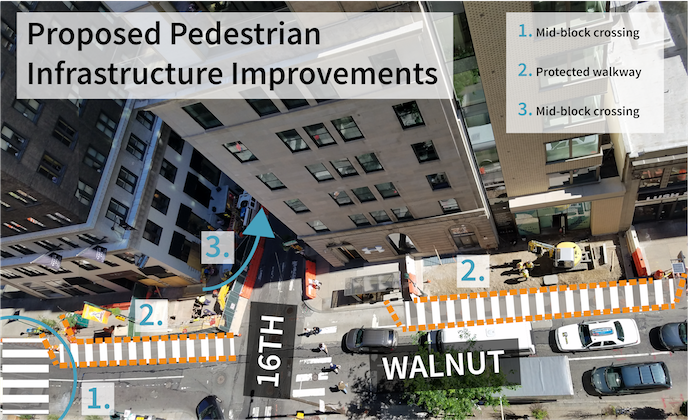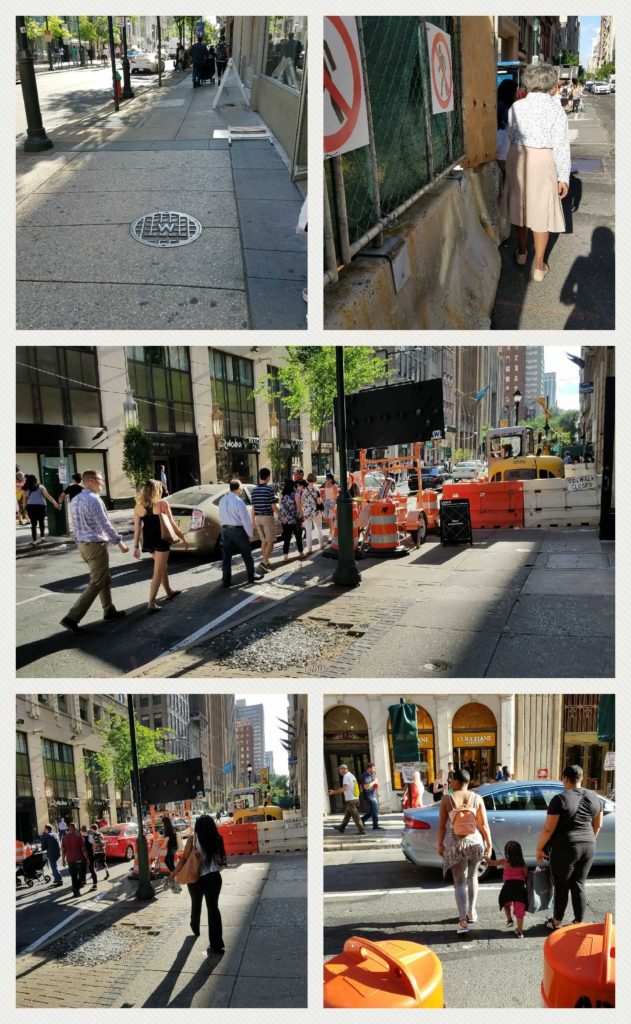
A common sight in many European cities are “shared streets”; streets where motorists, bicyclists and pedestrians use a street and sidewalk as if they are one and the same.
Motor vehicles move slowly through the streets and pedestrians and bicyclists weave in and out as they please.
If you want to see a unplanned shared street in Philadelphia that doesn’t work well, go take a look at Walnut Street between 15th and 17th Streets — or, really, most places where long-term construction is going on.
A contractor for Veolia Energy, the company that provides steam heat to many Philadelphia buildings and institutions, has torn up two NW and NE corners of the intersection of 16th and Walnut. Since late May and early June (in two phases), the sidewalks of the north side of Walnut Street have been closed to pedestrians.
As far as we can tell, the contractor is following the terms of their permit. In other words, the condition we’ve witnessed over the past two weeks is what the City of Philadelphia is permitting.
Here’s how pedestrians have responded to the sidewalk closures.
They either walk across Walnut in the middle of the block to the south side when they come upon the closure, or across 16th from the east to the west side of the street, or walk along the jersey barrier to the intersection corner and wade through the motor vehicles to the other side.
And why not? The A-frame signs telling to pedestrians to cross over at the corners of 17th and Walnut or 15th and Walnut have turned over or are too easily ignored. The stretch of sidewalk on the north side of 1500 and 1600 block of Walnut that is not torn up or blocked off are too long to purposely cross at 15th or 17th. Same for 16th Street. Motors vehicles are moving slowly enough that dashing across the street and walking in the travel lanes seems to make sense.
But, the sight of thousands of adults, seniors, people with disabilities, adults with children in strollers walking in between the jersey barriers and buses and cars for 20-50 feet or running across Walnut Street is downright disturbing. Two lanes of motor vehicles are still moving through, including buses and large trucks.
Is this how Philadelphia is manages sidewalk closures? It can and should do better.
According to the Delaware Valley Regional Planning Commission, Walnut and 16th Street have approximately 7,000 motor vehicles a day. Based on a count we conducted, Walnut Street has 20,000 pedestrians a day and 16th has 14,000 pedestrians a day. Why are motor vehicles given two lanes of travel and twice as many pedestrians given nothing more than signs and blaring speakers?
The situation is screaming for a fix.
Here are our suggestions for making 16th and Walnut a safer shared street while the construction continues (as noted in the image at the top of this post).
- Reduce the travel lanes from two to one on Walnut Street at the intersection of 16th Street
- Install a protected pedestrians walkway on the north side of Walnut and install a temporary mid-block crossing on Walnut Street in front of the Apple Store
- Install a temporary mid-block crossing on 16th Street
- Install an electronic sign at Broad and Walnut warning motorists about the traffic pattern and urging them to use other streets to cross West Center City



Thank you for this – especially for quantifying the number of pedestrians vs. motor vehicles. Sick and tired of even the most pedestrian-heavy streets in our city being mostly for moving and parked cars. Philadelphia can and should do better.
Why, cars pay for the roads, you obviously do not.